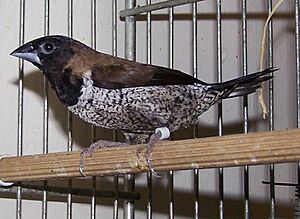Black-faced munia facts for kids
Quick facts for kids Black-faced munia |
|
|---|---|
 |
|
| Conservation status | |
| Scientific classification | |
| Genus: |
Lonchura
|
| Species: |
molucca
|
| Synonyms | |
|
Loxia molucca Linnaeus, 1766 |
|
The black-faced munia (Lonchura molucca) is a small, colorful bird. It lives in countries like Indonesia and East Timor. You can find these birds in many different places. They live in parks, gardens, forests, and open grassy areas.
This bird is a type of estrildid finch. This means it belongs to a family of small, seed-eating birds. A famous scientist named Carl Linnaeus first described this bird in 1766. Experts say this bird is not in danger. It is listed as a "least concern" species by the IUCN.
Contents
What is a Black-faced Munia?
Have you ever wondered how animals get their names? The black-faced munia got its scientific name from a Swedish naturalist named Carl Linnaeus. He officially described the bird in 1766. He gave it the name Loxia molucca. The word molucca refers to the Maluku Islands where the bird was found.
Today, this bird is placed in a group called Lonchura. This group was created by an English naturalist, William Henry Sykes, in 1832.
Different Kinds of Black-faced Munias
There are two main types, or subspecies, of the black-faced munia:
- L. m. molucca (Linnaeus, 1766) – You can find this type in Sulawesi and nearby islands. It also lives in most of the Maluku Islands, Gag, and Kofiau Islands.
- L. m. propinqua (Sharpe, 1890) – This type lives in the Kangean Islands. It is also found in the Lesser Sunda Islands all the way to the Tanimbar Islands.
How to Spot a Black-faced Munia
The black-faced munia is easy to recognize! It has a black face, throat, and the top part of its chest. The back of its neck and its main back feathers are dark brown. Its wings and tail are black.
The lower part of its body and its rump (the area above the tail) are white. These white parts have small black spots or stripes. The bird's beak is thick and has two colors. The top part is dark, and the bottom part is blue-gray. Its legs are dark too.
Where Do Black-faced Munias Live?
The black-faced munia is native to Indonesia. This includes a group of islands called Wallacea. It also lives in East Timor.
These birds love to eat seeds. You will often see them in small groups or flocks. They usually hang out in grassy areas where they can find plenty of food.
Is the Black-faced Munia in Danger?
Good news! The black-faced munia is found in many places. It is quite common in most areas. In some spots, there are lots of them!
Experts have not fully counted the number of these birds in Indonesia. However, it seems their population is staying steady. This bird does not face many big threats. Because of this, the International Union for Conservation of Nature (IUCN) says its conservation status is "least concern". This means it is not currently at risk of disappearing.


